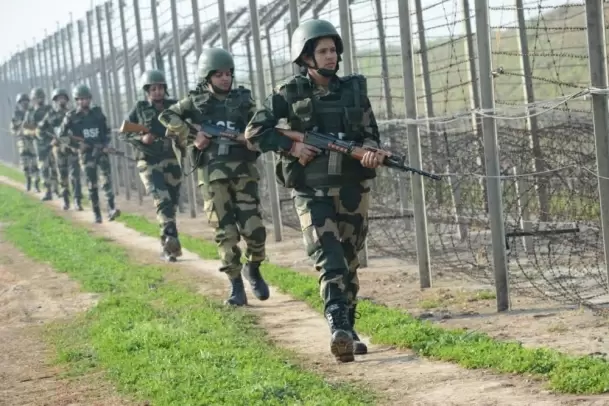India handed over 577 intruders to B'desh since 2018 (IANS Exclusive)
13-June-2021

In a gesture of mutual cooperation and emphasis on the well-being of the border populations of both the countries, India has handed as many as 577 Bangladeshi intruders to the neighbouring country since 2018, and the numbers this year have been quite good in the first five months, with over 100 people returned to their country.
Officials in the Border Security Force (BSF) said these intruders were caught and handed over to the Border Guard Bangladesh (BGB) -- the border guarding force of the neighbouring country, which shares 4,096 km borders with India.
As the India-Bangladesh border is considered to be the most peaceful International Border, both the countries ensure to maintain their relations and such good will gestures are shown from both sides during the flag meetings of the border guarding forces of the two nations.
Of these 577 Bangladeshi intruders, there were women, children and men belonging to the villages located near to the borders.
Most of the times, these illegal infiltrators sneaked into the Indian territory by crossing the International Boundary (IB) in search of jobs.
The villagers could sneak into the Indian territory, as most portions of the India-Bangladesh border, the fifth-longest land border in the world, are porous.
The India-Bangladesh border connects 262 km in Assam, 856 km in Tripura, 318 km in Mizoram, 443 km in Meghalaya, and 2,217 km in West Bengal.
As per the data, 480 of these intruders had entered into the Indian territory through West Bengal, 71 through Tripura, 18 via Meghalaya and eight through Assam.
All the 577 intruders were handed over to Bangladesh between January 1, 2018 and May 21 this year.
As many as 129 Bangladeshis were held by the BSF this year till May 21 and were handed over to the BGB. Of these, 116 had entered into India through West Bengal, nine via Tripura, three through Meghalaya and one through Assam.
The figures this year so far indicate that illegal entry may touch or cross the maximum of 262 illegal infiltrations noted in 2018.
In 2020, 116 Bangladeshis were caught and handed over to the BGB. Of them, 91 had entered through West Bengal, 17 through Tripura, five via Assam and three through Meghalaya.
In 2019, 70 intruders were held and handed over to Bangladesh, the lowest. Of these, 38 illegal entries were noted through West Bengal, 19 via Tripura, 12 through Meghalaya and one through Assam.
A total of 262 Bangladeshis were returned back to their country in 2018, the highest so far. Of them, 235 had entered into the Indian territory through West Bengal, 26 through Tripura and one through Assam.
Earlier this month, the BSF had sent back a Bangladeshi teenager who had strayed into the Indian territory. The 12-year-old youth, identified as Hasanur Jamal Abhik, was handed over to the BGB during a flag meeting between the two border guarding forces at the BSF Border Outpost Dawki and BGB Border Outpost Tamabil.
A resident of Savar area in Dhaka district, the Bangladeshi teenager was found roaming in Dawki village on June 6 by the locals, who handed him over to the police. He was handed over to the BGB on June 7.
To overcome this problem, as well as to prevent illegal trafficking of cattle, humans, drugs, fake Indian currency notes (FICN) and many more things, the Ministry of Home Affairs had in 2017 decided to employ a technological solution, besides the physical presence of BSF personnel.
In January 2018, the information and technology wing of the BSF undertook project BOLD-QIT (Border Electronically Dominated QRT Interception Technique), under the Comprehensive Integrated Border Management System (CIBMS), and completed it in record time with the technical support of various manufacturers and suppliers.
BOLD-QIT is a project aimed to install technical systems under the CIBMS, enabling the BSF to equip the Indo-Bangla border in the unfenced riverine areas of the Brahmaputra and its tributaries with various kinds of sensors.
Now, the entire span of the Brahmaputra has been covered with the data network generated by Microwave communication, OFC cables, DMR communication, day and night surveillance cameras and intrusion detection systems.
These modern gadgets provide feeds to the BSF control rooms along the borders and enable the paramilitary force's quick reaction teams to thwart any possibility of illegal border crossing and crimes.
At various places, it is not possible to erect border fences due to geographical barriers, and the Indian government is taking help of electronic gadgets like these to secure the India-Bangladesh border from illegal infiltraion.-IANS
Suspended Kerala IAS Officer Prasanth Raises Promotion Demand During Hearing
How BluSmart Promoters Diverted EV Loans, Bought Flat In DLF Camellias
Homegrown Coffee Chain Nothing Before Coffee Raises $2.3 Million Funding
Supreme Court to Hear Pleas Challenging Waqf Act 2025 Today
Kerala Minister Slams NCERT for Hindi Titles in English Textbooks








